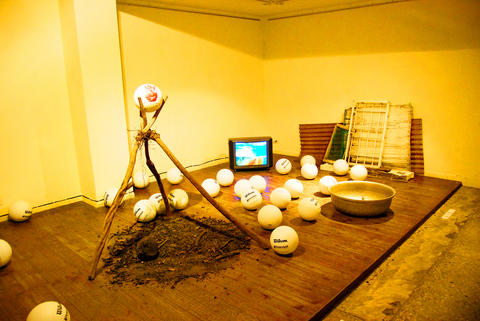It's the end of the year and the Taipei Times looks back at some great art moments and peers into its crystal ball to predict five up-and-coming artists/trends to watch out for. In keeping with the festive season, we'll count down like it's New Year's Eve:
5. Tseng Yu-chin (曾御欽) had his video work displayed at Germany's prestigious Documenta exhibition this summer. What was noteworthy was that he was not filling any quotas or participating in a national presentation. Rather he was included because he's an exceptional artist ready to participate at an international level. He recently embarked on a six-month art residency in New York.
4. Sean Hu Chao-sheng (胡朝聖). Okay, he's not an artist. He's a curator. His first experience was with land art and he's curated some notable exhibitions this year such as Lin Chuan-Chu's (林銓居) rice field/painting studio in Dazhi, Fashion Accidentally at Taipei MOCA and Very Fun Park in Taipei's East District (東區). What is remarkable about Hu's curatorship is his inclusiveness. He does not only invite ethnic Taiwanese for his exhibitions, which most Taiwanese curators tend to do, he includes artists and designers from various ethnicities, gender identifications and art practices to participate. Other curators, should take note.

PHOTO: SUSAN KENDZULAK
3. One of the best works created this year was by Yao Jui-chung (姚瑞中). Yao is no novice as he's already exhibited at the Venice Biennale, plus numerous other exhibitions. He's also known for curating shows and having authored several books. But the video he made where he's slowly goose-stepping about the CKS Statue Park in Tashi (大溪) Township, Taoyuan County, hits the bull's-eye. In this age of "desinicization," Yao's mockery of statues and idols is timely, comical and a tad visionary.
2. Number two is not an artist, nor a curator, but rather the notable status of the equality of women in Taiwan's art institutions: Lin Mun-lee (林曼麗) is director of the National Palace Museum; Lai Hsiang-ling (賴香伶) is coming to the end of her two-year contract with Taipei MOCA; Hsieh Hsiou-yun (謝小韞) is director of the Taipei Fine Arts Museum and Ava Hsueh (薛保瑕) is director of the National Taiwan Museum in Taichung.
1. Hands down! Our big winner for the year, undoubtedly, is Kuo I-chen (郭奕臣). Kuo seamlessly merges high-tech gadgetry with profound metaphysical concerns making him stand apart in Taiwan's contemporary art scene. He got off to a running start by first exhibiting at 2004's Taipei Biennial, when he was just a student, well, a grad student. This summer his participation in Thermocline: New Asian Waves at ZKM in Karlsruhe, Germany, brought him acclaim. The Centre Pompidou has bought his work for its collection. In October, he had four simultaneous exhibitions that featured work showing a destroyed earth but which demonstrated humanity's hope for survival. Meanwhile, international curators are flocking to his studio. The art world will have to wait, however, as Kuo just started his military service.

Oct. 27 to Nov. 2 Over a breakfast of soymilk and fried dough costing less than NT$400, seven officials and engineers agreed on a NT$400 million plan — unaware that it would mark the beginning of Taiwan’s semiconductor empire. It was a cold February morning in 1974. Gathered at the unassuming shop were Economics minister Sun Yun-hsuan (孫運璿), director-general of Transportation and Communications Kao Yu-shu (高玉樹), Industrial Technology Research Institute (ITRI) president Wang Chao-chen (王兆振), Telecommunications Laboratories director Kang Pao-huang (康寶煌), Executive Yuan secretary-general Fei Hua (費驊), director-general of Telecommunications Fang Hsien-chi (方賢齊) and Radio Corporation of America (RCA) Laboratories director Pan
The consensus on the Chinese Nationalist Party (KMT) chair race is that Cheng Li-wun (鄭麗文) ran a populist, ideological back-to-basics campaign and soundly defeated former Taipei mayor Hau Lung-bin (郝龍斌), the candidate backed by the big institutional players. Cheng tapped into a wave of popular enthusiasm within the KMT, while the institutional players’ get-out-the-vote abilities fell flat, suggesting their power has weakened significantly. Yet, a closer look at the race paints a more complicated picture, raising questions about some analysts’ conclusions, including my own. TURNOUT Here is a surprising statistic: Turnout was 130,678, or 39.46 percent of the 331,145 eligible party

The classic warmth of a good old-fashioned izakaya beckons you in, all cozy nooks and dark wood finishes, as tables order a third round and waiters sling tapas-sized bites and assorted — sometimes unidentifiable — skewered meats. But there’s a romantic hush about this Ximending (西門町) hotspot, with cocktails savored, plating elegant and never rushed and daters and diners lit by candlelight and chandelier. Each chair is mismatched and the assorted tables appear to be the fanciest picks from a nearby flea market. A naked sewing mannequin stands in a dimly lit corner, adorned with antique mirrors and draped foliage

The election of Cheng Li-wun (鄭麗文) as chair of the Chinese Nationalist Party (KMT) marked a triumphant return of pride in the “Chinese” in the party name. Cheng wants Taiwanese to be proud to call themselves Chinese again. The unambiguous winner was a return to the KMT ideology that formed in the early 2000s under then chairman Lien Chan (連戰) and president Ma Ying-jeou (馬英九) put into practice as far as he could, until ultimately thwarted by hundreds of thousands of protestors thronging the streets in what became known as the Sunflower movement in 2014. Cheng is an unambiguous Chinese ethnonationalist,